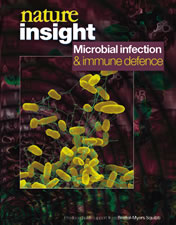Microbial infection
and immune defence
Vol. 406, No. 6797 (17 August 2000).
|![]() PDF
PDF![]() (190
(190![]() K)
K)![]() |
|
 |
Cover
illustration |
Despite the extensive use of antibiotics and vaccination programmes, infectious diseases continue to be a leading cause of morbidity and mortality worldwide. Widespread antibiotic resistance, the emergence of new pathogens in addition to the resurgence of old ones, and the lack of effective new therapeutics exacerbate the problems.
The new approaches that are needed to deal with this increasing threat will come from the integration of two of the most active areas of biomedical research: the molecular and cellular basis of microbial pathogenesis, and the nature and manipulation of immune defence. In this month's Insight, we examine how bacteria attack and survive in the host, the mechanisms that the host uses to defend itself, and the therapeutic strategies that can be used to buttress these defences. As this is such a large and complex topic, we focus on bacterial disease; important health hazards such as HIV infection and malaria will be addressed in future Insights.
Individual articles discuss the changing patterns of infectious disease, strategies by which enteric pathogens establish infection, and the sophisticated methods that bacteria use to combat antibiotics. The innate immune system constitutes the first line of defence against infectious disease, and two articles describe the triggering of Toll-like receptors on the surface of extracellular bacteria and the ability of mycobacterial lipids to trigger T-cell responses through presentation on non-classical class I molecules. The final two papers explore the generation of vaccines against intracellular pathogens and how microbial genome sequencing will offer new approaches to the treatment and diagnosis of infectious disease.
We hope that both general readers as well as experts in the field will find these articles useful and informative.
Ursula Weiss Senior Editor
| On
the particularity of pathogens BARRY R. BLOOM In the elemental struggle between pathogenic microbes and the immune system of the host, each strives for a unique advantage and thus each exploits its own unique particularities in pathogenesis and protection. And each presumably selects for the diversity that generally characterizes the wide range of successful host–pathogen interactions.
| 760 | ||
| Changing
patterns of infectious disease MITCHELL L. COHEN
| 762 | ||
| Pathogenic
strategies of enteric bacteria MICHAEL S. DONNENBERG
| 768 | ||
| Molecular
mechanisms that confer antibacterial drug resistance CHRISTOPHER WALSH
| 775 | ||
| Toll-like
receptors in the induction of the innate immune response ALAN ADEREM AND RICHARD J. ULEVITCH
| 782 | ||
| CD1-restricted
T-cell responses and microbial infection SE-HO PARK AND ALBERT BENDELAC
| 788 | ||
| Vaccines
against intracellular infections requiring cellular immunity ROBERT A. SEDER AND ADRIAN V. S. HILL
| 793 | ||
| Microbial
genome sequencing CLAIRE M. FRASER, JONATHAN A. EISEN & STEVEN L. SALZBERG
| 799 | ||
Bristol-Myers
Squibb and microbial disease
| 804 | ||
